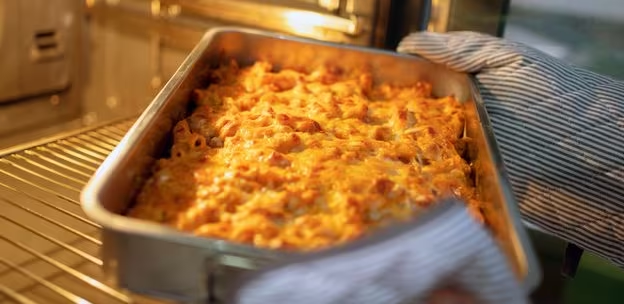The enslaved man who popularised mac and cheese
BBC | 26.11.2025 20:00
The baked dish is one of the US's most popular foods, but its rise can likely be traced back to an enslaved Black chef who worked for Thomas Jefferson.
This year, as millions of families in the US sit down to celebrate Thanksgiving, many will tuck into one of the most quintessentially "American" foods: macaroni and cheese. But while some sources trace the baked dish's mysterious origins to Italy or Switzerland, the dish as Americans know it today may have been popularised in the New World via an unlikely figure – an enslaved chef named James Hemings.
In 1784, long before he became president, Thomas Jefferson was appointed US minister to France and brought Hemings with him. Jefferson wanted the young man to be trained as a chef so he could preside over the kitchen at Monticello, his plantation estate in Virginia. But Hemings was more than just Jefferson's potential chef; he was also the half-brother of Jefferson's first wife, Martha, and the brother of Sally Hemings, the enslaved girl who looked after Jefferson's daughter and later bore six of his children.
"[Hemings'] relationship with Jefferson is very interesting," said Nicole Brown, a historian at Monticello, noting that this familial connection may have given Hemings certain opportunities denied to other enslaved people. "He [was] constantly negotiating and renegotiating with Jefferson in ways that you might not traditionally think of an enslaved person being able to do."
In Paris, Hemings trained as both a chef de cuisine and pastry chef. "[Hemings was] not only one of the first French-trained chefs from the United States, but certainly one of the first Black French-trained chefs," Brown said.
After five years in Paris, Hemings brought his new skills back to the US and served as Jefferson's head chef at Monticello, as well as in New York and Philadelphia, until he was able to negotiate his own freedom in 1796. Using French techniques such as braising, poaching and sautéing, he created delicate dishes that would have been almost unheard of in 18th-Century America, including the "snow egg", a poached meringue served floating in crème anglaise. Since pasta baked with cheese had become a popular dish in France by the time Hemings trained there, he likely learned this there and brought it back to the US as well.
As Hemings served these French-inspired dishes to dignitaries, American socialites and many of the era's top tastemakers up and down the east coast, many of his dishes and cooking methods became de rigueur in households across the newly formed nation. According to Brown, most American foods of the time would have been cooked over a hearth or in an open fireplace. Hemings' dishes however, required more advanced methods and a stew stove, the precursor to the modern stove, which would have allowed for greater control over the heat. As the well-to-do guests who dined with Jefferson wanted to emulate Hemings' cooking style, the enslaved chef began to heavily influence the US's culinary culture.
"The way that we eat [in America], the way that we cook, the foods that we celebrate, all these different things come to [us through] the lens of that one moment where Thomas Jefferson brought this person to [Paris]," said chef Omar Tate, whose newly opened Philadelphia restaurant Honeysuckle serves dishes from across the African diaspora. "He technically was a celebrity chef because everyone knew the slave that Thomas Jefferson had [in his kitchen]."
The baked dish then called "macaroni pie", was a particular favourite of Jefferson's and was frequently served at his table. Hemings' version was created by cooking the macaroni in a mixture of milk and water, and then layering cheese and butter with the cooked pasta before baking.
It's unknown whether the "macaroni pie" served at Monticello during Hemings' time as chef was a faithful recreation of what was being served in Paris during in late 18th Century or whether Hemings altered it to suit his own – or more likely, Jefferson's – tastes. What is known is that over the following century, dishes resembling Hemings' version became more widespread across the US, helped along by a combination of broader trends.
First, the influx of Italian immigrants in the 1880s increased the availability of pasta in the US. At the same time, industrialisation transformed both pasta-making and cheese-making, allowing factories to mass produce ingredients that would previously have been difficult to obtain. In 1937, the Kraft company introduced a boxed version of macaroni and cheese as a cheap and easy meal during the Great Depression. (Its slogan was: "Make a meal for four in nine minutes".) During World War Two, people could purchase two boxes for a single ration point, cementing its place in American home cooking.
Today mac and cheese is a $2.9bn industry, and some sources say the average American eats it 22 times a year – second only to pizza. Yet, the man who may have first introduced it to American diners is only now becoming more widely recognised.
 Thomas Jefferson's Monticello
Thomas Jefferson's MonticelloAt Monticello, guests can learn about Hemings' legacy on the museum's From Slavery to Freedom walking tour, which honours the more than 600 men, women and children enslaved at the plantation from 1770 until Jefferson's death in 1826. The museum's website also sheds light on Hemings' fascinating life, including the fact that he earned a minimal wage in Paris even as an enslaved man, which allowed him to hire a French tutor while living abroad. Hemings' story has also been featured in books and documentaries, including an episode of Stephen Satterfield's Netflix series High on the Hog and the documentary James Hemings: Ghost in America's Kitchen.
More like this:
• Five historic restaurants that fed the civil rights movement
Hemings' legacy is part of a growing understanding of how much of the US's food culture can be traced back to enslaved African Americans, whose roles in shaping popular American dishes have largely been unacknowledged. These include figures such as Hercules Posy, the enslaved chef who cooked for George Washington and was known for his complex sauces and dishes like oyster stew, as well as the countless unnamed Black cooks and caterers who brought dishes like rice, cornbread and grits (some of which also have Native American roots) to American tables.
"[Hemings was] this incredible person with this really powerful personality," said Brown. "[He] is so unique in that he's better educated than most people in the United States… and yet, because you are deemed as being Black and [enslaved], you never attain the equality that [a white person in that] position would have."
More than 200 years after his death, one of America's first celebrity chefs is now finally being recognised for his contributions to the nation's food culture.
--
If you liked this story, sign up for The Essential List newsletter – a handpicked selection of features, videos and can't-miss news, delivered to your inbox twice a week.









